The exercises proceed apace, building finishes and the skll set to accomplish them.
I fully expect to reprise this workshop at Joshua’s next summer, along with perhaps a couple other offerings. Introduction to Parquetry is taking place the end of next week, so come on and join us.













The description of this year’s class is identical to previous year’s so I thought I’d just have a gallery of student activities day by day.
I expect I’ll teach this again next summer at Wood and Shop.










Recently for the umpteenth time (25th? 30th?) over the past four decades I taught my Introduction to Historic Woodfinishing workshop, this time at Joshua Farnsworth’s Wood and Shop School near Charlottesville. I have already related the transition from teaching at The Barn once my insurance underwriter yanked the plug on liability insurance for students, bringing the “school” component of The Barn on White Run to an end. Joshua graciously invited me to teach at his place, for which I am very much appreciative. I’m teaching a Parquetry workshop in a couple weeks, there are openings.
 33
33
The odd thing about teaching workshops at The Barn is that I still have personal liability insurance, the building and its contents are insured as before, but no insurance for students attending classes. The underwriters would never say why that insurance was being canceled, but my agent thought it was because the nearest full-service hospital is almost 90 minutes away. Oddly enough I can still host visitors for one-one-one learning experiences, and in fact I have one of those upcoming as soon as we can work out our scheduling hiccups.

One of the great benefits to hosting all the workshops in my own Barn classroom was that everything I needed was right there. When I teach elsewhere I have to pack up everything for the course. Everything. All the supplies, tools, workpieces, everything. I learned my lesson the first couple times I taught almost forty years ago and sent the students a detailed list of everything they would need. Every class there was a student or two who arrived unprepared, saying “I didn’t think you meant that,” or “I decided to substitute this or that.” In every instance the whole class was delayed repeatedly while I tried to come up with a reasonable substitute, but it never worked out to my satisfaction.

Now I just bring everything necessary for the full experience of my syllabus. Yes, it takes me a week or longer to compile the pile, yes it takes a day to load my truck to overflowing, yes it takes me about four hours to get set up wherever I am teaching. But it yields the learning experience I want to impart.
And the title of this post? It took me 26 trips to move everything from my barn into the truck, then 26 trips from my truck up the stairs into Joshua’s shop. Three days later I had only 23 trips from his shop to my truck as the students consumed the “missing” three tubs worth.
Stay tuned.
Recently the Venn Diagram of Life had enough overlap that I was able to address the problem of the blanched finish on the sill/shelf of the new bay window in the dining room. As you may recall, I trimmed out the window with antique cherry I had in my stash, and sealed the shelf with epoxy because there was a 100% chance that Mrs. Barn would be using it to hold plants. In order to unify the overall appearance of the window and shelf, I glazed the veneered pine shelf with an oil stain to match the cherry.

It looked grand until I varnished over the glazing with P&L 38 that then blushed overnight as it dried. I mean, the kind of blushing when we were spraying cellulose nitrate on a muggy July day in South Florida.
A reader wrote to tell me that an amine component of the epoxy hardener was the culprit. Despite several efforts to mitigate the whitened surface it remained in place, leading me to the inescapable conclusion that the oil varnish and the oil glaze underneath it had to come off.



The time for that to occur had finally arrived and the combination of a low-odor stripper with the open windows inflicted minimal affect inside the house. A very small test area worked well, a larger test area confirmed my path of execution.


My method was to brush on some low odor paint remover, cover that with aluminum foil, and let it work its magic for about three hours.

At the end of that time the foil was peeled back and the now-dissolve varnish and stain scraped/wiped off slicker’n cat snot.

My original plan was to introduce a colorant into a new application of the varnish to achieve the same cherry tone, but the fact is we like the contrast so much I am going to leave it looking just the way it is. I’ll rub out the epoxy finish and call it “done.”

As a general rule, in olden days paste wax was made from one of two recipes — Beeswax melted into Spirits of Turpentine (what we call simply turpentine), or beeswax melted into tallow. I’ve made much of Version 1 in the paste but not so much of Version 2. So, to best talk to visitors about the finishing processes of the past at the recent 18th Century Trades Fair I made a good batch of tallow/beeswax paste, and I gotta tell you it was magnificent! I think it actually has some advantages over the turpentine/beeswax solvent paste, namely that it does not have a volatile component to evaporate, is basically odorless (may not be an “advantage” for those who like the fragrance of turpentine), and it is harder in the jar than the turpentine beeswax paste. This means that the doling out can be more easily controlled and that less is used to accomplish the same goals as with the solvent paste. I especially like the feel of the tallow paste wax and have been using it on my tools to great success.
I like it so much I just might make a batch of it to share with others who might like to try some. If this is you, let me know.
N.B. Things have been crazy busy in a wonderful way and I’m looking forward to a more sedate pace in the coming days. Stay tuned. — DCW
Three weeks ago I gathered with 10 novitiate varnishistas from around the country for a three-day romp down the long and winding trail of historic woodfinishing hosted by Joshua Farnsworth at his Wood and Shop facility near Charlottesville VA. Over the years I have evolved a very tight syllabus to make sure every participant leaves with a set of successful exercises under their belts, or fingernails as the case may be. This solid foundation allows me to work around the edges and incorporate some new things as I did this year, with mixed success.


A large part of the course success is due to the fact that I supply EVERYTHING for the students to use. Though that is a substantial undertaking it does guarantee a greater chance of success than if I mail out a supplies-and-tools list. After a couple experiences of wasting several hours of class time scrounging up supplies, tools, and projects for the students who forgot them I tossed that concept overboard many years ago.
The routine should be fairly familiar to anyone who follows this blog, so this year I will simply be posting a gallery of images to capsulize the three days. There is no way a few pictures can convey fully the richness of the event from either a learning or fellowship perspective, plus there were many portions where I had no pictures because I was, well, teaching. There are entire exercises that were not included in the photos.
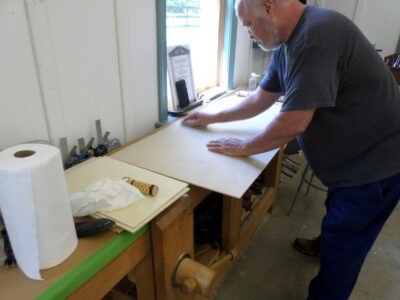
Smoothing the 24″ x 48″ birch plywood panels in preparation for fifteen coats of 1-1/2-pound lemon shellac.

Shellac makes its first appearance
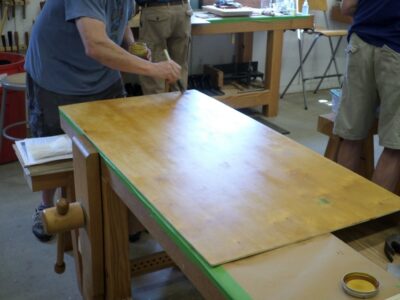
The end of the “first inning” (five brushed coats of shellac)
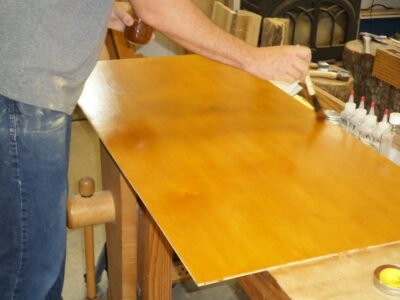
After drying for several hours, we ended Day 1 with a light scuffing of 220 sandpaper followed by another five brush coats of shellac.

After drying overnight following the “second inning,” the surface was uniformly scraped, followed by a “third inning” of five coats and set aside to dry for 24 hours.

The final steps for the large panel included dividing it into quadrants, each of which was treated differently. This quadrant was dry-pumiced in preparation for shellac pad polishing.
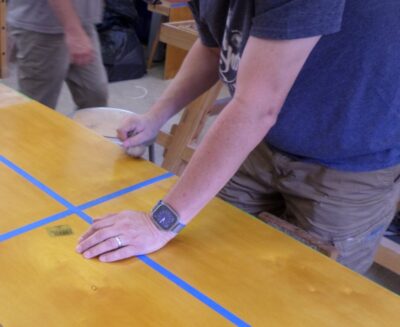
Final shellac varnish pad polishing.
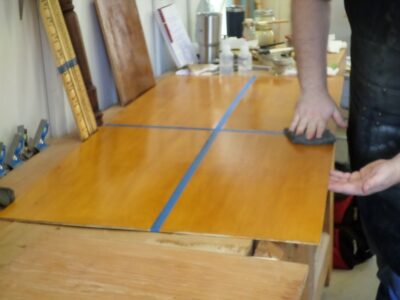
A second quadrant was polished with tripoli (rottenstone) in white spirits, the third was rubbed strenuously with Liberson 0000 steel wool saturated with paste wax, and the fourth was left “off the brush.”

Smoothing a mahogany panel with a pumice block.
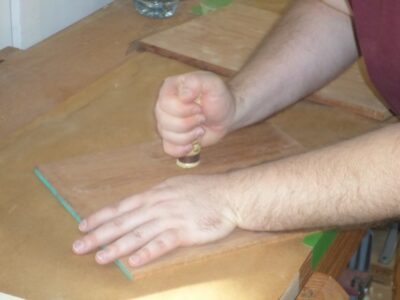
Working the mahogany panel with a 1″ x 1/8″ polissoir, followed by molten beeswax (scraped clean) as a grain filler.

Making and using a linen pounce/pad to apply the 1/2-pound shellac varnish.
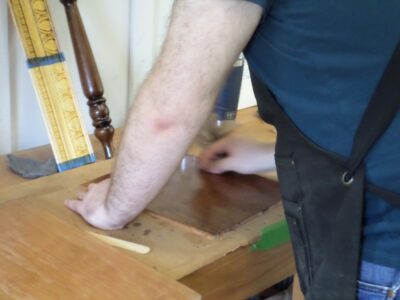
Building the padded shellac varnish.
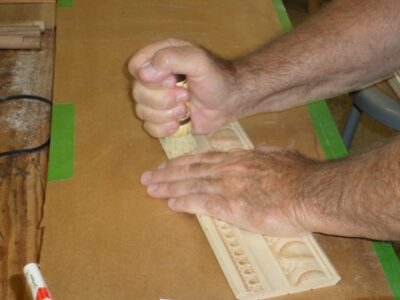
Burnishing an embossed molding with the Carver’s Model polissoir, followed by a few coats of brushed shellac.

Revisiting the shellacked surface with the Carver’s Polissoir.

Applying asphalt glazing to half of the molding piece.

Feathering out the asphalt glazing with a badger brush.
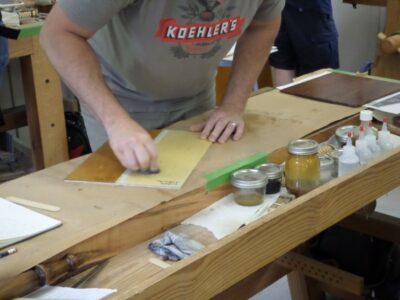
Comparing the appearance of five coats each of Bullseye Amber and Bullseye Clear from the hardware store.

A classroom full of busy varnishers.
And much, much more.
So there’s a snapshot (pun intended) of the recent gathering. I know we will have the class again next summer at the school in Earlysville VA.
Perhaps it’s an age thing, perhaps it’s a “working alone” thing, but I have had a lot of time reminiscing lately while up in the barn.
50+ years ago when as a teen and newly arrived into a real-live cabinet shop I was introduced to the deep-seated passions of European craftsmen. Prior to that I was a “scratch and dent” man at a couple of furniture stores, which, though a legitimate service, is not the same as working alongside men with years of apprentice training and decades of life on the job.
This shop was operated by a New Yawker of Greek heritage and produced amazing interiors with frame-and-panel rooms, carved detailing, and exquisite finishing. (I was an underling in the finishing room; they did not consider my week(?) at a Mohawk workshop to be really valid for what they did and trained me in their way of doing things enough that I could next catch on to the Schindler’s shop where I spent the following few years) Since the talent pool in south Florida was not up to his standards the owner hired guys from Long Island to come and work there, they were amazing craftsmen/artists.
Hans was a German-trained cabinetmaker in charge of that side of things. Joe was an Italian who was my boss in the finishing room. Both men were incredibly generous in teaching me what they knew at a level I was able to learn, and sometimes that created conflict between them when Hans said one thing and Joe said another. I mean, real conflict to the point where the big boss had to step in and send them back to their corners.


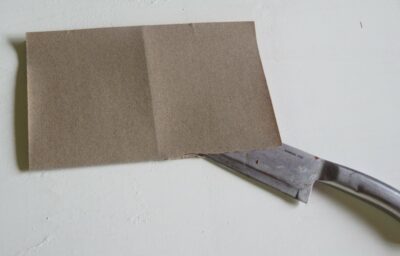


Perhaps the most intense quarrel I recall was about how to fold sandpaper. Really. Hans was insistent on the “quartering” method of preparing and using sandpaper. In this technique the sandpaper was twice folded in half along the perpendicular center lines, then cut to the cross-fold along one line then folded into a stacked quarter. According to him, this was the only way a REAL craftsman used sandpaper.

Joe bristled at both this method and the insinuation that he was not a REAL craftsman (they were both just shy of magicians in their work). According to Joe the only true method for preparing and using sandpaper was to cut the sheet in half along the short axis, then fold the paper twice to yield three identical sections when folded over. To be honest a version of this method is the one I have used more often in the subsequent five decades.

But the experience of watching two late-middle-aged men almost coming to blows over how to cut, fold, and use sandpaper was indelibly burned into my memory and provided a lot of insight into the human condition. If we want to, we can gin up conflict over the most inconsequential things while letting the existential stuff slide by with barely a notice.
Design? Pshaw. Construction details? Shrug. Finishing schedule? Whatever.
But sandpaper? Put ’em up, buddy.

These are the handouts of the syllabus for the upcoming Introduction to Historic Woodfinishing workshop, honed over the years and the dozens of times I’ve taught the workshop. About the only changes I make any more are if the course schedule is truncated to be shorter than the three days I have here.


In my collection of 3,000+ vinyl albums is the Pink Floyd double live album Ummagumma, with the memorable photograph of their traveling equipment artistically arranged on a landing strip.

It is reminiscent of my own preparations for my upcoming Introduction to Historic Woodfinishing next week in Earlysville VA. As I’ve said previously, I found out long ago that the only way I could make the workshop complete and beneficial for all the attendees was to provide absolutely everything they need, in terms of workpieces, tools, and supplies. And that adds up to quite a pile of materials.

At this point I’m about 2/3 of the way there. All I know is that by the time I pull out of here next Wednesday the bed of my truck will be full.
Whew! Concluding a few months of mostly traveling we got back to Shangri-la late Sunday evening after driving non-stop from Alabama, where L’il T’s family just moved (we were “helping,” a/k/a grandparenting L’il T and his brother). Travel advisory — avoid Chattanooga if at all possible, the construction and attendant constriction made it a more than an hour of stop and go experience at 97 degrees.
I am looking forward to resuming some semblance of norma life, including full days in the shop. This is made possible by the cessation of travel for most of the foreseeable future, along with finding a sturdy Mennonite lad to do most of the yard work. We were spending 3-4 days a week just keeping the grass cut, brush beat back, and trimming the edges. This young man could do what is necessary in 3-4 hours, rather than 3-4 days. Oh, to have the exuberance and fortitude of the young! That plus a $10k lawnmower makes a big difference.
Other than routine chores around the homestead I’ll be preparing for a Labor Day Weekend shindig at my friend Tim’s place, celebrating the historic crafts of our ancestors. I’ll be assembling a vintage-form tool kit to fit into my antique cabinetmaker’s tool chest which has been used as storage for the past couple decades. So, I’ll be there with tools and one of my Nicholson workbenches, in period costume, probably making a small dowry chest. If you are in the region, stop on by.
In addition I’ll be ramping up for my only teaching event of the year, a 3-day Introduction to Historic Woodfinishing workshop near Charlottesville VA.
And resuming work on my magnum opus tool cabinet, and oh by the way L’il T is now big enough to use a step stool to wash his hands and brush his teeth. The ones I made for his mom and aunt are still in service after 35+ years.
And my traveling tool kit needs completing. As do a couple of Gragg chairs. And those half-finished Studley mallet exercises, and the patterns for the genuine replicas. And the custom oculars for my rifle scopes, bypassing the now nearly defunct right eye (dominant). And the boat load of writing and editing staring me in the face. And setting up a video system to make in-shop vids after I get the Gragg video edited. And tuning my ripple molder.
And, and, and…
























 33
33










































Recent Comments